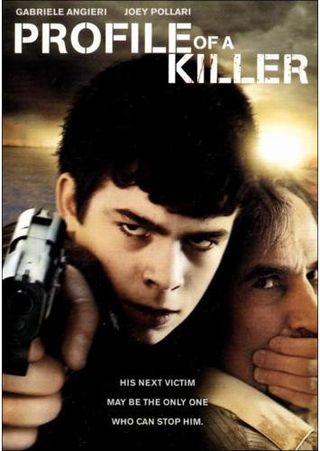Zombos Says: Good
Profile of a Killer (2012) is a movie that, ultimately, fails to explain why characters behave the way they do, but director and writer Caspian Tredwell-Owen manages to keep us asking anyway.
He focuses on three people: David (Joey Pollari), the teenage killer; Saul (Gabriele Angieri), the almost-retired FBI Profiler who David wants very much to meet; and Rachel (Emily Fradenburgh), the special agent who reluctantly works with Saul until David kidnaps him. Then she works hard at finding Saul and David as more victims, old and new, come to the surface. Or she works as hard, at least, as Fradenburgh can project her acting acumen up to.
Of the three, Rachel is the weakest participant when she needs to be the driving force for all the actions taking place to find killer and profiler. Fradenburgh has one facial expression, one mood, and one modus operandi. Her backstory is the least fulfilling, the least explained, which seriously releases the steam built up from those moments when we are listening in on Saul and David's tete-a-tetes: David desparately needs Saul to profile him, an active killer, and Saul wants to understand David's motives to stop him; but both of them are asking the same question: why am I/why are you killing? The simplicity of this question propels Profile of a Killer along, and can either generate much turmoil for both men, or it can overwhelm the storyline with expedient banalaties cobbled together from the numerous movies about killers that have come at us in all shapes and sizes and levels of sanity and gruesomeness.
Is David like the killer Bobby Thompson in Targets? Or is David a stone cold killer like Anton in No Country for Old Men? We see David's not hungry for his victims' livers (not yet, anyway), but he kills randomly (or so it seems) , forcing Saul to put up or shut up and watch helplessly. What little we learn about David gives no justification for his actions. The Wall of Success his mom's pinned up for him embarrasses him, so we know he's not a Norman Bates with a mother complex. He's not even a thrill killer like Mickey in Natural Born Killers. He alternates between regretting what he does and needing to do it.
Oddly, Tredwell-Owen's camera maintains a steady eye as David flips through slideshow presentations of his intended victims, which is an anachronism given David's laptop nearby with the pictures he's painstakingly turning into slides for the projector. And how does he manage to make those slides within the confines of the abandoned dairy farmhouse? But anachronistic stylistic conventions aside, watch the camera as it fixes on Saul and David, steadily framing them , and slowly, very slowly, moving toward them as they challenge each other with questions and become agitated with the lack of answers.
Contrast this with how the camera handles Rachel's scenes. Perhaps Treadwell-Owen realizes Fradenburgh dissipates any tension in those frames her character appears in, so he shakes the handheld camera, slightly, to energize the frame? Or maybe he's playing on our expectations of who is actually in control, or not in control, of the situation? An unsteady camera usually implies disorientation, unease, or something not quite right. But the unsteadiness and unease is Rachel's, not David's.
Treadwell-Owen, like Rachel, can't seem to alter his tone or mood beyond morose, keeping Profile of a Killer weighted down in moments when it should spring forward, and there are times when his camera moves more than the depth of his characters. But unlike the anemic vampire academies and tireless retreads of worn movie plots, Profile of a Killer aims its premise between sensationalism and drama with a rare spin on the serial killer genre that emphasizes the relationship (which seems like that of a father and son) between the older profiler and the younger killer more than a cat and mouse game of wits. Here, they share the same goal: both want answers and to live.




Comments